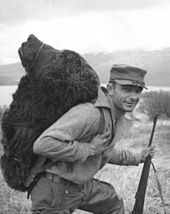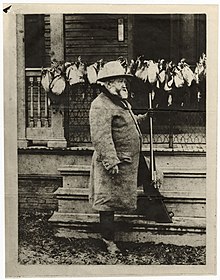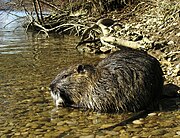
Hunting is the human practice of seeking, pursuing, capturing, or killing wildlife or feral animals. The most common reasons for humans to hunt are to exploit the animal's body for meat and useful animal products, for recreation/taxidermy, although it may also be done for non-exploitative reasons such as removing predators dangerous to humans or domestic animals, to eliminate pests and nuisance animals that damage crops/livestock/poultry or spread diseases, for trade/tourism, or for ecological conservation against overpopulation and invasive species.

Game or quarry is any wild animal hunted for animal products, for recreation ("sporting"), or for trophies. The species of animals hunted as game varies in different parts of the world and by different local jurisdictions, though most are terrestrial mammals and birds. Fish caught non-commercially are also referred to as game fish.
The Migratory Bird Treaty Act of 1918 (MBTA), codified at 16 U.S.C. §§ 703–712, is a United States federal law, first enacted in 1918 to implement the convention for the protection of migratory birds between the United States and Canada. The statute makes it unlawful without a waiver to pursue, hunt, take, capture, kill, or sell nearly 1,100 species of birds listed therein as migratory birds. The statute does not discriminate between live or dead birds and also grants full protection to any bird parts including feathers, eggs, and nests. A March 2020 update of the list increased the number of species to 1,093.

The Kentucky Department of Fish and Wildlife Resources, an agency of the Kentucky Tourism, Arts and Heritage Cabinet, is responsible for the conservation of wildlife resources and for boating projects in the state. A commissioner appointed by the Fish and Wildlife Commission heads the department. The commission—which oversees the department's commissioner and promulgates regulations governing fishing, hunting, and boating—is a nine-member bipartisan board appointed by the governor from a list of candidates nominated by active hunters and anglers in each of nine geographic districts in the state.
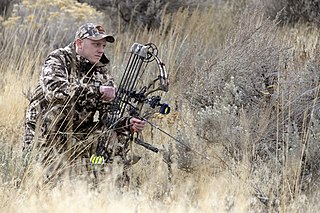
Bowhunting is the practice of hunting game animals by archery. Many indigenous peoples have employed the technique as their primary hunting method for thousands of years, and it has survived into contemporary use for sport and hunting.

Shot is a collective term for small spheres or pellets, often made of lead. These have been projected from slings since ancient times and were the original projectiles for shotguns and are still fired primarily from shotguns and grenade launchers, while it's less commonly used in riot guns. Shot shells are also available in many handgun calibers in a configuration known as "birdshot", "rat shot", or "snake shot".

Wildlife management is the management process influencing interactions among and between wildlife, its habitats and people to achieve predefined impacts. It attempts to balance the needs of wildlife with the needs of people using the best available science. Wildlife management can include wildlife conservation, gamekeeping and pest control. Wildlife management draws on disciplines such as mathematics, chemistry, biology, ecology, climatology and geography to gain the best results.

Game laws are statutes which regulate the right to pursue and hunt certain kinds of wild animals and fish. The scope of game laws can include the following:
Legislation on hunting with dogs is in place in many countries around the world. Legislation may regulate, or in some cases prohibit the use of dogs to hunt or flush wild animal species.

Waterfowl hunting is the practice of hunting aquatic birds such as ducks, geese and other waterfowls or shorebirds for food and sport.

The National Wildlife Refuge System in the United States has a long and distinguished history.

Big-game hunting is the hunting of large game animals for trophies, taxidermy, meat, and commercially valuable animal by-products. The term is often associated with the hunting of Africa's "Big Five" games, and Indian rhinoceros and Bengal tigers on the Indian subcontinent.
A bag limit is a law imposed on hunters and fishermen restricting the number of animals within a specific species or group of species they may kill and keep. Size limits and hunting seasons sometimes accompany bag limits which place restrictions on the size of those animals and the time of year during which hunters may legally kill them. Those who violate these laws or other hunting laws are known as poachers.
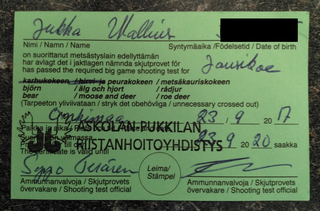
A hunting license or hunting permit is a regulatory or legal mechanism to control hunting, both commercial and recreational. A license specifically made for recreational hunting is sometimes called a game license.

Sanganois State Fish and Wildlife Area is an Illinois state park on 10,360 acres (4,190 ha) in Cass, Schuyler, and Mason County, Illinois, United States.
A hunting season is the designated time in which certain game animals can be killed in certain designated areas. In the United States, each state determines and sets its own specific dates to hunt the certain game animal, such as California, in which they designate certain zones, in which each have their own separate dates in order to legally hunt.
Romania has a long history of hunting and remains a remarkable hunting destination, drawing many hunters because of its large numbers of brown bears, wolves, wild boars, red deer, and chamois. The concentration of brown bears in the Carpathian Mountains of central Romania is largest in the world and contains half of all Europe's population, except Russia.
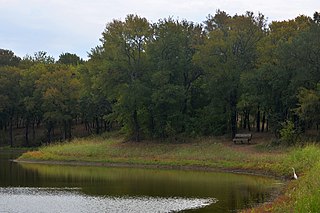
Hagerman National Wildlife Refuge (HNWR), a haven for migratory birds and other wildlife, lies in northwestern Grayson County, Texas, on the Big Mineral Arm of Lake Texoma, on the Red River between Oklahoma and Texas. This National Wildlife Refuge is made up of water, marsh, and upland habitat. Visitors can hike, observe wildlife, hunt, and fish throughout the year.
Australia has a population of about 25 million, with the Commonwealth Government's 2019 survey estimating there are 640,000 recreational hunters in the country. There are around 5.8 million legally owned guns in Australia, ranging from airguns to single-shot, bolt-action, pump-action, lever-action or semi-automatic firearms.
Fair chase is a term used by hunters to describe an ethical approach to hunting big game animals. North America's oldest wildlife conservation group, the Boone and Crockett Club, defines "fair chase" as requiring the targeted game animal to be wild and free-ranging. "Wild" refers to an animal that is naturally bred and lives freely in nature. "Free-ranging" means an animal that is not restrained by traps or artificial barriers, so it has a fair chance of successfully escaping from the hunt.

